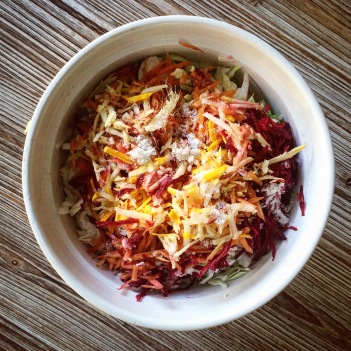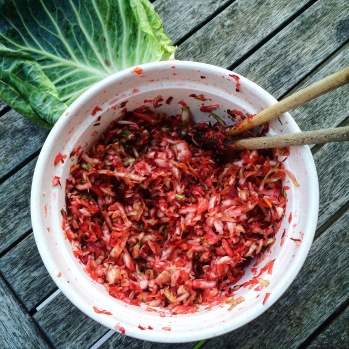Sauerkraut; literally in German, ‘sour’ (OK, it also does mean ‘pickled’) ‘herb’. Probably not the most appetizing-sounding food on this planet and perhaps not the easiest to convert older children to love but its tang can become extremely addictive. It is also a food that as I child, I would turn my nose up at as some very smelly culinary relic of the past, one that only thigh-slapping, Leder-Hosen clad Germans consumed at the annual Oktoberfest, along with their endless streams of beer. ( I know, I had a very non-stereotypical notion of German culture at the time!) And that smell, well I get such a kick out of passing my fermentation cupboard a few days after getting a fresh batch started and it now makes my heart sing. Amazing how things can change. My cultural awareness has fortunately matured somewhat since then too. Travel and studies of foreign languages helped dispel a few myths but a few persisted nevertheless, even when getting personally acquainted with Germany’s food and culture.
What I did notice, as an exercise and calorie-obsessed 80’s teenage poster child, was how much hearty food these people could eat. Thinking back, the words I’m sure I used were more like ‘fatty’ and ‘unhealthy’ but these were the 80s, the era when low-fat foods and carbohydrates like pasta were touted as the ultimate in health and weight loss panaceas. I remember looking at healthy, slim women in Germany putting away huge schnitzels for lunch, along with a good serving of sauerkraut or salads and be completely perplexed at the incongruity of it all.

I didn’t think to question my own low-fat, high-carb diet as ‘everyone knew’ that was the way to go… if you wanted bad gut-health, weight problems and auto-immune disease, which unfortunately I only realised when my children were primary school-aged and sometimes not that well. It was when I discovered the GAPS diet by Dr Natasha-Campbell McBride, that puzzle pieces finally began to fit together and our health started to turn around. That’s where I learned that addictive habits of my younger self like low-fat, high-starch food, diet soft drinks with artificial sweeteners, a taste for poor-quality fast food and an extremely cavalier attitude towards the use of antibiotics had been setting up my body for disease through their inevitable result; very poor gut health or gut dysbiosis.
Finally those slim and healthy Germans eating proteins and fermented vegetables made sense. That’s when sauerkraut and other pro-biotic food and drink (from the Greek meaning ‘promoting life’) came into play. Just take a guess then as to what anti-biotic means…I first thought that popping a probiotic capsule would take care of that. I still do take very good therapeutic-grade probiotics to help repopulate my gut with as much good bacteria as possible but I’ve learned that consuming a variety of fermented foods and drink is a must for maintaining excellent health.
I remember feeling really daunted about the prospect of making my own. I was living in France at the time where sauerkraut wasn’t that readily available. I was also feeling a bit overwhelmed by the different fermentation kits available over the internet and was determined to find a ‘no-frills’ method of fermenting cabbage. I finally found one which required kitchen basics that I already had; a ceramic (not plastic or metal) bowl, wooden spoons, a plate (to push the mixture down) and a weight (to keep the sauerkraut submerged in its liquid). I often use a full, heavy glass bottle for this. Although you can just use cabbage and nothing else, once you’ve had success with the basic formula once or twice you’ll probably want a bit of variety, so I’m giving you my recipe for my ‘fancy’ sauerkraut, although you may choose to only begin with the cabbage and introduce other ingredients into subsequent batches. Play with ingredients you love and then add it to your meals, knowing you’re doing yourself and your family so much good.

Utensils
(which should best be washed in hot water and sterilized in oven for approximately 20 minutes at 120 degrees celcius)
- 1 deep ceramic bowl
- 1 flat plate to fit onto sauerkraut mixture
- good chopping knife/grater/food processor
- chopping board
- heavy weight to keep mixture submerged in liquid under plate
- 2 wooden spoons ( or anything else to pummel liquid with, preferably not metal though)
- great music to pummel that sauerkraut to and get the juices going (non-sterilized!)

Ingredients
- 1 small or 1/2 large cabbage head, washed, with outer few leaves also washed and removed
- 1 large beetroot, washed and peeled
- 1 large carrot, washed and peeled
- 2 apples, washed
- several garlic cloves, peeled
- good chunk of turmeric, washed and peeled
- good chunk of ginger, washed and peeled
- good-quality sea salt ( I love grey celtic or French sea salt)
Method
- Finely chop and grate all of the vegetables (I like to start with the cabbage as it’s the main ingredient and use that as the first, bottom layer in the bowl).
- Place 1/3 to 1/4 of finely shredded cabbage onto bottom of bowl.

- Sprinkle cabbage with small teaspoon of sea salt.
- Place a similar ratio of grated beetroot, carrot, apple and spices onto the cabbage layer.
- Sprinkle this layer with some more sea salt.
- Continue this layering of cabbage/salt/veggies&spices/salt until the bowl is full, finishing with a final layer of cabbage and salt. Try not to be too heavy-handed with the salt. I was a bit scared of bad bacteria growing the first few times and over-compensated with way too much salt. It’ll be just fine with enough.
- Grab those wooden spoons and with one in each hand, start pummeling the sauerkraut mixture.( I usually do this for about 15 minutes until all of the veggies are undistinguishable and have had a lot of their water released).

- At this stage you have two options; you may either transfer the mixture into sterilized mason jars which you press down with a small plate and weight until the mixture is submerged in its liquid. Or you can keep it in the bowl and similarly push down mixture with a plate and weight. I like to pop the washed cabbage leaf between the mixture and plate as another layer in this process.
- If there isn’t enough liquid, ( which can happen if the veggies aren’t that fresh and slightly dehydrated, add sufficient filtered water to the mixture).
- It’s also a good idea to cover the bowl or container with a muslin cloth and elastic band. This needs to be left somewhere to ferment at room temperature for the desired time. My average is about 10 days as I like it tangy but depending on the season and ambient temperature it can be ‘ready’ in as little as several days or you might want it going for several weeks. Once ready, store in fridge to prevent further fermentation.

Have fun with it. Making your own is very satisfying and if you’ve never tried it before, it’s a simple, inexpensive way to introduce probiotics into your diet. I would love to hear how you go. If you have any questions, I’d be happy to answer them and if you do end up making some, I’d love to see your results. Happy fermentation!
I am trying your recipe with garlic and tumeric right now. I usually pop in a little fermented brine or kraut juice from previous ferments just to give a bit of a start. I am looking forward to trying the new batch in a few weeks.
LikeLike
That’s fabulous! Let me know what you think. I know I prefer the extra zing from adding ginger and turmeric. Do you usually pummel your kraut? I usually add some of the previous batch’s liquid to kvass or other fermented foods but haven’t before for sauerkraut. Do you think it ferments quicker this way? Hmm. How long do you usually ferment for? 😊
LikeLike
I don’t go as long as you for ferments as I do it on the kitchen bench where it is warm so only about 3-4 days then in the fridge where it will continue to ferment slowly. I think it gets going quicker with a bit of brine or kraut juice in. I use my hands to pummel, squeeze and squish until lots of juice comes out. We love our kraut and fermented vegetables and kvass. Only been fermenting about a year but I am loving it, will let you know what I think of your new zingy version. Xx
LikeLiked by 1 person
Yes, let me know, Alex. Fermenting is so much fun. I love the way that everyone seems to have their little tricks to fermenting. So much to learn but luckily it’s a pretty forgiving, robust process. x
LikeLike
I am soooo going to make this! I am very new to fermenting (I’ve only ever fermented cabbage twice), so your instructions really help!
Also, what a good point you made with the pro- and anti-biotic meaning in greek (I’m Greek, so I totally get it, but haven’t really given it any thought up until now, I used the words mechanically)!
Thanks!
LikeLike
It’s funny, but most people use words automatically, not thinking about their true meanings and origins, including me. It’s fun to dig a bit into etymology, isn’t it? Thanks so much for your comment. I’m so happy to hear that you find my instructions helpful. I would love to know how you go with it and please share a photo of your sauerkraut. All of your dishes are always so beautiful. I’m sure you’ll do an amazing job. x
LikeLike
Hi, I just checked out your lovely blog. Unfortunately I don’t understand Greek but I just wanted to say that it looks fabulous and I wish my language knowledge extended to Greek. x
LikeLike
I love that you used apples in this recipe! I have never used fruit when it comes to fermentation before – so that is something I would definitely be interested in trying! This article was great and very informative – I can’t wait to try your recipe! Thanks again for sharing.
LikeLike
Thanks so much, I’m glad you enjoyed reading it. I mix up the fermenting a bit, often with whatever I have spare in the fridge, so no real hard and fast rules. Let me know how you go.
LikeLike